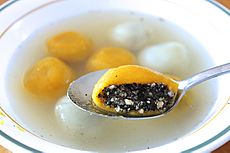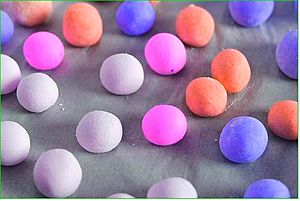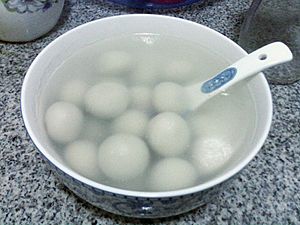Tangyuan (food) facts for kids

Tangyuan made from pumpkin, filled with black sesame (黑芝麻) paste
|
|
| Alternative names | yuanxiao |
|---|---|
| Place of origin | China |
| Region or state | East Asia |
| Main ingredients | Glutinous rice flour |
| Variations | Regional variants differing in ingredients and method |
| Other information | Traditionally consumed during Yuanxiao (Lantern Festival) |
| Tangyuan | |||||||||||||||||
|---|---|---|---|---|---|---|---|---|---|---|---|---|---|---|---|---|---|
| Traditional Chinese | 湯圓 or 湯團 | ||||||||||||||||
| Simplified Chinese | 汤圆 or 汤团 | ||||||||||||||||
| Hanyu Pinyin | tāngyuán or tāngtuán | ||||||||||||||||
|
|||||||||||||||||
| Yuanxiao | |||||||||||||||||
| Chinese | 元宵 | ||||||||||||||||
| Hanyu Pinyin | yuán xiāo | ||||||||||||||||
|
|||||||||||||||||
| Second alternative Chinese name | |||||||||||||||||
| Traditional Chinese | 圓仔 or 米圓 | ||||||||||||||||
| Simplified Chinese | 圆仔 or 米圆 | ||||||||||||||||
| Hanyu Pinyin | yuánzǐ or mǐyuán | ||||||||||||||||
|
|||||||||||||||||
Tangyuan (traditional Chinese: 湯圓; simplified Chinese: 汤圆; pinyin: tāngyuán; literally "soup ball") is a yummy traditional Chinese dessert. It is made from glutinous rice shaped into a ball. These soft, chewy balls are served in a warm soup or sweet syrup.
Tangyuan can be small like a marble or as big as a ping pong ball. Sometimes, they have a tasty filling inside. People traditionally eat Tangyuan during the Lantern Festival. Its name sounds like the Chinese word for "union" or "togetherness." Because of this, Tangyuan also symbolizes family coming together. You might see it served at weddings, family reunions, Chinese New Year, and the Dōngzhì (winter solstice) festival.
Contents
History of Tangyuan
Tangyuan has been a part of Chinese culture for over 2,000 years! It is traditionally eaten during the Lantern Festival. This festival happens on the 15th day of the first month of the lunar new year. This is when the first full moon of the year appears. The Lantern Festival usually falls in February on our calendar. People eat Tangyuan then for good luck. They hope it will bring sweetness and joy into their lives.
Traditional Fillings and Their Origins
The first Tangyuan fillings were made from sesame, peanuts, sugar, and animal fat. Did you know that some of these ingredients came from far away? The Silk Road and the Maritime Silk Road were old trade routes. They helped people exchange goods and ideas. Sesame seeds came from Central Asia during the Han Dynasty (202-220 BC). Peanuts arrived from the Philippines during the Ming Dynasty (1368-1644).
How Tangyuan Got Its Name
Over the years, Tangyuan has had different names. During the Yongle era of the Ming Dynasty, people in northern China called it Yuanxiao. This name came from the Yuanxiao Festival. Yuanxiao means "first evening." "Yuan" means round or full, and "xiao" means night.
People in southern China called the dish Tangyuan or Tangtuan. In the Hakka and Cantonese languages, Tangyuan sounds like "tong rhen" or "tong jyun."
There's a cool story about the name change! From 1912 to 1916, a leader named Yuan Shikai ruled China. He didn't like the name yuanxiao (Chinese: 元宵). This was because it sounded like "remove Yuan" (Chinese: 袁消), which was his last name! So, he ordered the name to be changed to Tangyuan. This new name means "round balls in soup" or "round dumplings in soup."
Today, "Tangyuan" usually refers to the southern style. "Yuanxiao" refers to the northern style. The main difference between them is how they are made.
Northern vs. Southern Styles
Tangyuan comes from southern China. In northern China, people call a similar dish Yuanxiao. Both are glutinous rice balls with fillings. Both are eaten during the Lantern Festival and other important events. Even though they look alike, they are made differently!
- Yuanxiao (Northern style):
* Has sweet and firm fillings. * Served in a thick soup. * Its outside is usually dry and soft. * Doesn't stay fresh for long. * To make it, the firm filling is cut into small pieces. These pieces are dipped in water, then rolled in dry glutinous rice flour many times until they become round.
- Tangyuan (Southern style):
* Can have many kinds of soft fillings, both sweet and savory. * Served in a thinner soup. * Its texture is smooth and chewy. * Can be stored frozen for a long time. * To make it, soft filling is wrapped inside a glutinous rice "dough." Then it's shaped into a ball by hand. * The soup it's served in changes based on the filling. Savory ones might be in a broth with daikon radish and fish cake. Sweet ones are often in tong sui, which means "sugar water."
Cultural Significance
For many Chinese families, Tangyuan is more than just a dessert. It is traditionally eaten during the Lantern Festival, Chinese New Year, and family gatherings. Its round shape and the round bowls it's served in are very important. They symbolize togetherness, unity, and family reunion.
What is Tangyuan Like?

Tangyuan is a delicious dessert with a soft, chewy texture and a gentle taste. It can be served simply as a plain white ball. But it can also be filled, colored, fried, or boiled. Making Tangyuan is a bit like making dumplings. You wrap the glutinous rice dough around a filling and shape it into a ball with your hands.
Tangyuan can be sweet or savory. Traditional sweet fillings often include black sesame. Sweet Tangyuan is often served in a syrup flavored with ginger. Savory Tangyuan is served in a clear soup broth. If Tangyuan has no filling, it can be served in a sweet dessert soup called tong sui (which means "sugar water") in Cantonese cooking.
Common Soup Bases
- Red bean soup
- Black sesame soup
- Ginger and rock sugar
- Fermented glutinous rice (Chinese: 醪糟 or 酒釀), Sweet Osmanthus, and rock sugar
Even though Tangyuan started as a special treat for festivals, it is now eaten all year round. As it became more popular, new versions appeared. These new Tangyuan might have different fillings, shapes, or colors. For example, you might find Tangyuan with chocolate or custard fillings instead of the traditional ones.
Sweet Fillings
- Black sesame (mixed with sugar)
- Crushed peanuts (mixed with sugar)
- Jujube paste
- Chocolate paste (softened butter mixed with cocoa powder)
- Red bean paste (Azuki bean)
- Lotus seed paste
- Matcha paste
- Custard
Savory Fillings
- Crushed peanuts
- Minced meat
- Mushroom
- Cabbage
Where to Find Tangyuan
The most famous kinds of Tangyuan come from Ningbo in Zhejiang Province, China. But people eat them all over China.
Tangyuan is also connected to the Winter Solstice and Chinese New Year in different places. Today, you can find and eat Tangyuan any time of the year. Large amounts of Tangyuan are made in factories. You can often find them in the frozen food section of Asian supermarkets, both in China and in other countries.
Tangyuan Around Asia
As this Chinese dessert became popular, other countries in Asia created their own versions!
China
Yuanxiao is very similar to Tangyuan. People often confuse them or use their names as if they mean the same thing. Like Tangyuan, Yuanxiao is a glutinous rice ball with filling. It's eaten during the Lantern Festival and other important gatherings. But they are made differently! Yuanxiao comes from northern China. It has sweet and firm fillings, like sesame and bean paste. It's served in a thick soup. Its outside is usually dry and soft and it doesn't stay fresh for long.
Muah Chee is another similar dish from southern China. It's a sticky dough made from glutinous flour that is steamed. It's then cut into small pieces and covered with sugar and finely crushed roasted peanuts or toasted sesame seeds.
Jiandui (
| Tangyuan | |||||||
|---|---|---|---|---|---|---|---|
| Traditional Chinese | 煎䭔 | ||||||
|
|||||||
), also called Sesame Balls, is a type of Tangyuan. It's made with glutinous rice flour, then fried and covered with sesame seeds. This gives it a crispy, chewy texture. The inside is hollow and can be filled with lotus paste, black sesame, or red bean paste.
Japan
Japanese Daifukumochi is similar to Tangyuan. It first came from Southeast Asia during the Heian period. People in Japan eat it during the New Year. This traditional Japanese dessert is mochi (glutinous rice) filled with sweet paste like anko, which is a sweet red bean paste from azuki beans. While Daifukumochi is like Tangyuan, it's made differently. A process called wet milling is used to make it chewy, but it's not as soft as Tangyuan.
Indonesia
In Indonesia, there's a version called Wedang Ronde. Wedang in Javanese means beverage, and Ronde means round ball. It's a popular food to eat when it's cold. The round, colorful glutinous rice balls can be filled with crushed peanuts and sugar, or left plain. They are served in a sweet, mild ginger broth. This broth is often boiled with fragrant pandan leaves. You can also add crushed, toasted peanuts, tapioca pearls, and slices of coconut.
Myanmar (Burma)
In Myanmar (Burma), mont lone yay baw (မုန့်လုံးရေပေါ်) is a traditional festive dish. It's served during Thingyan and filled with pieces of jaggery. It's usually served with coconut shavings.
Philippines
In the Philippines, ginataang bilo-bilò is served in coconut milk. Sometimes, local foods like plantains (sabà), tapioca, and/or sweet potatoes are added. The traditional Chinese Tangyuan is often called "chiōng-uân-îⁿ" (Chinese: 狀元圓; Pe̍h-ōe-jī: chiōng-goân-îⁿ) or "siōng-guân-îⁿ" (Chinese: 上元圓; Pe̍h-ōe-jī: siōng-goân-îⁿ) by Chinese Filipinos in Hokkien.
Thailand
In Thailand, bua loi (บัวลอย) is a sweet dish. It has glutinous rice flour balls in coconut milk or ginger syrup.
Southern Vietnam
In southern Vietnam, a similar dish is called chè xôi nước. It's served in a mild, sweet liquid flavored with grated ginger root. In northern Vietnam, bánh trôi (also called bánh trôi nước) and bánh chay are similar. Bánh chay is served with coconut milk.
See also
 In Spanish: Tangyuan para niños
In Spanish: Tangyuan para niños


